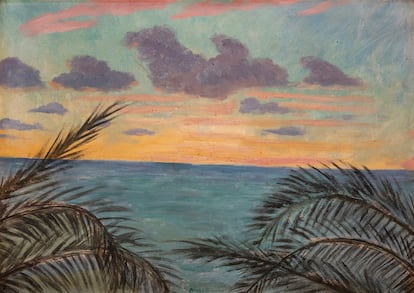Diego Rivera’s Acapulco: A late piece by the Mexican muralist is up for auction
The retired artist depicted a 1956 tropical sunset over the Pacific Ocean in one of his rare, unexhibited oil paintings


A tropical landscape in Acapulco. The setting depicts a romantic sunset, bathed in the golden glow of the fading sun, flanked by palm trees against an intense blue sea, exuding a gentle and tender aura. This oil painting on canvas bears the signature of the renowned Mexican muralist, Diego Rivera, and is part of a collection that will be auctioned by the Morton Subastas auction house on March 14. Valued initially between 1.6 and 2.2 million pesos ($95,000-$120,000), Rivera’s painting will be auctioned with works by other modern and contemporary Mexican artists including Dr. Atl, Rufino Tamayo, Sergio Hernández, David Alfaro Siqueiros and José Clemente Orozco. “It’s a piece that hardly anyone has seen, which makes it even more appealing,” said Diana Álvarez, a modern art specialist at Morton. “The special thing about it is that it’s a view of Acapulco from Diego Rivera’s later period. It’s different from his usual social art that speaks to the Mexican public,” she said. The artist’s paintbrush forgets about Marxism for a while to embrace a bohemian perspective, one that will soon be accompanied by the sound of the auctioneer’s hammer.
Rivera was battling prostate cancer as he settled in Acapulco during its heyday, when the city attracted the most glamorous faces from Hollywood. The beaches were visited by the likes of Rita Hayworth, Elizabeth Taylor, Frank Sinatra, Gary Cooper and Cary Grant. Here, the artist found tranquility and inspiration, surrounded by the breathtaking beauty of a bay that, despite the current violence, decay and hurricane devastation, still manages to evoke wistful admiration. “Rivera was heavily influenced by socialism, and his easel work is pretty minimal, done towards the end of his life. These paintings are not your usual Rivera style. They’re more personal, reflecting a quieter side of Rivera in his final days. That’s what makes this painting extra special,” said Álvarez.
Morton’s experts say there is not much information about this Rivera piece. The auction house knows it’s authentic as it’s dated, signed by the author, and comes with a certificate of authenticity from art historian Xavier Moyssén issued in 1990. “It’s a different vision of Mexico by Rivera. Although the piece wasn’t documented, it’s likely a private commission that changed hands several times. It was never displayed publicly,” said Morton expert Ana Segoviano.
The auction is set for March 14, with specialists, collectors and museum representatives expected. Those without a hefty checkbook can visit Morton’s gallery in Las Lomas de Chapultepec, Mexico City, showcasing works by Rivera, Dr. Atl and Sergio Hernández. The auction offers 311 lots, including paintings, graphic works, sculptures and drawings.

Mexico has emerged as a prominent market for modern and contemporary art in Latin America. María Fernanda Serrano, manager of Morton’s Art Department, notes a significant influx of collectors from the United States, Europe, and Asia seeking valuable art pieces. “This market has been robust and stable for many numerous years. Mexico boasts a vast selection, attracting collectors in search of contemporary Latin American art,” said Serrano. She says the country’s laws are stringent, designating the works of eight Mexican creators as cultural heritage. These pieces cannot be taken abroad without exhibition permits. “If a piece was created overseas, such as several of Rivera’s works in the United States, it can be sold. However, if a Mexican purchases it and brings it back to Mexico, it cannot leave again. Collectors may acquire it, but artwork of that nature remain in Mexico.”
Morton holds seven to eight auctions yearly, including a major Latin American art auction every May. They assist owners in consigning and valuing art pieces for optimal market value. Factors like the artist, period and size influence art prices. The house verifies the origin of pieces, and if the artist is still alive, Morton will contact them directly. Experts have confirmed that Rivera’s painting was made in 1956, just before his death. It’s unique as there are limited pieces by famous artists depicting Acapulco’s port.
The last Rivera piece auctioned by Morton was Paisaje de Fontenay, signed and dated 1917, fetching 15.4 million pesos ($920,000). It belongs to the cubist phase of the artist, who spent a significant amount of time in France in the early 1900s, refining his artistic style and engaging with key people in the art world. This piece was displayed at the Palace of Fine Arts in Mexico City before entering a private collection. Despite Rivera’s acclaim as a prominent Mexican muralist, his partner and fellow artist, Frida Kahlo, surpassed him in 2021 as the most sought-after Latin American artist. One of Kahlo’s last portraits of the Mexican painter, Diego y yo (1949), broke the record for a Latin American artist at auction, when it sold for $34.9 million. It was also a record for a female artist. Los Rivales by Rivera fetched $10 million in 2018. “There’s a whole boom of Frida’s work going on, which is pretty fashionable these days,” said Serrano. “But finding an original piece by Frida nowadays is quite a challenge.” Serrano and the entire team at Morton Subastas are eager for the hammer to resound loudly, hoping that an admirer of Rivera’s artistry will generously bid for his enchanting Acapulco sunset.
Sign up for our weekly newsletter to get more English-language news coverage from EL PAÍS USA Edition
Tu suscripción se está usando en otro dispositivo
¿Quieres añadir otro usuario a tu suscripción?
Si continúas leyendo en este dispositivo, no se podrá leer en el otro.
FlechaTu suscripción se está usando en otro dispositivo y solo puedes acceder a EL PAÍS desde un dispositivo a la vez.
Si quieres compartir tu cuenta, cambia tu suscripción a la modalidad Premium, así podrás añadir otro usuario. Cada uno accederá con su propia cuenta de email, lo que os permitirá personalizar vuestra experiencia en EL PAÍS.
¿Tienes una suscripción de empresa? Accede aquí para contratar más cuentas.
En el caso de no saber quién está usando tu cuenta, te recomendamos cambiar tu contraseña aquí.
Si decides continuar compartiendo tu cuenta, este mensaje se mostrará en tu dispositivo y en el de la otra persona que está usando tu cuenta de forma indefinida, afectando a tu experiencia de lectura. Puedes consultar aquí los términos y condiciones de la suscripción digital.
More information
Archived In
Últimas noticias
Tiger Woods turns 50: Will he continue playing on the PGA Tour or take a back seat?
The surreal journey of James Nnaji, the Barcelona youth player selected in the NBA Draft who ended up in the NCAA
Trump claims peace in Ukraine is near, but Moscow suggests otherwise
A survivor’s account of the Interoceanic Train accident: ‘We were scared because of the speed on the curve’
Most viewed
- Oona Chaplin: ‘I told James Cameron that I was living in a treehouse and starting a permaculture project with a friend’
- Reinhard Genzel, Nobel laureate in physics: ‘One-minute videos will never give you the truth’
- Why the price of coffee has skyrocketed: from Brazilian plantations to specialty coffee houses
- Pablo Escobar’s hippos: A serious environmental problem, 40 years on
- Chevy Chase, the beloved comedian who was a monster off camera: ‘Not everyone hated him, just the people who’ve worked with him’










































